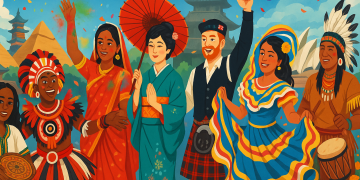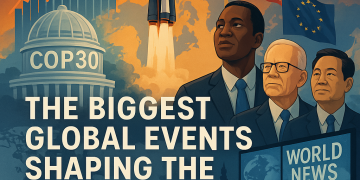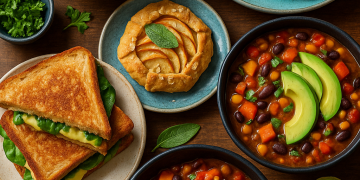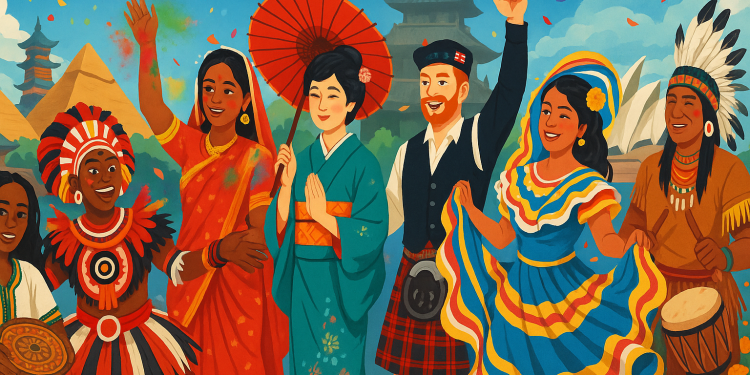Introduction: Why Learning About World Cultures Matters
In a world that grows more connected by the second, understanding world cultures is not just enriching—it’s essential. Whether you’re planning a trip, building international friendships, or working in a diverse team, knowing about international traditions and global customs opens doors, breaks down barriers, and sparks unforgettable experiences. Let’s embark on a journey around the globe, revealing the stories, ceremonies, and everyday habits that make each place—and its people—one of a kind.
1. Africa: Living Heritage and Community Spirit
Africa is the birthplace of humanity and a continent alive with cultural diversity—over 2,000 languages, countless ethnic groups, and traditions as old as time.
a. Ghana – The Naming Ceremony (Outdooring)
In Ghana, the birth of a child is marked with an “Outdooring”—a celebration where the newborn is introduced to the community on the eighth day. Elders bless the baby, names are chosen for spiritual and ancestral significance, and everyone joins in with music, dancing, and shared meals.
b. Ethiopia – The Coffee Ceremony
Ethiopia, home of coffee, turns a simple drink into a multi-hour ritual. Raw beans are roasted, ground, and brewed while friends and family gather, talk, and connect. Hospitality, patience, and respect are all part of this cherished custom.
c. Nigeria – The Yoruba Gelede Festival
Every year, Yoruba communities stage vibrant Gelede masquerades. Colorful masks and costumes honor women—mothers, ancestors, and deities—reminding all of the balance between the spiritual and earthly worlds.
2. Asia: Ancient Wisdom and Modern Wonder
Asia’s population and geography are vast, and so is its variety of unique world experiences.
a. India – Holi, The Festival of Colors
Holi celebrates the victory of good over evil and the arrival of spring. Streets come alive as people throw colored powders, sing, and dance together. It’s messy, magical, and wonderfully inclusive.
b. Japan – The Tea Ceremony (Chanoyu)
More than a drink, Japanese tea ceremonies are about mindfulness, harmony, and aesthetic appreciation. Every movement—from folding the napkin to whisking the matcha—is a meditative act.
c. Thailand – The Wai Greeting
In Thailand, you’ll often be welcomed with a “wai”—palms pressed together and a slight bow. The wai’s height and depth show respect, age, and social standing, reflecting Thailand’s value of humility and harmony.
3. Europe: Timeless Traditions and Vibrant Festivals
Europe is a patchwork of countries and cultures, each with customs that blend old-world roots and modern celebration.
a. Spain – La Tomatina
Each August, the small town of Buñol hosts the world’s biggest food fight: La Tomatina. Thousands of people pelt each other with ripe tomatoes, just for fun! Afterward, everyone gathers for music and paella.
b. Scotland – The Highland Games
Scotland’s Highland Games blend sport, music, and pageantry. Competitors toss cabers, play bagpipes, and dance in kilts—honoring Scottish heritage and community spirit.
c. Italy – The Passeggiata
Every evening in Italian towns, people dress up and stroll through the main streets—the “passeggiata.” It’s about being seen, socializing, and savoring life’s simple pleasures.
4. North America: Blending Traditions Old and New
North America is a melting pot, where Native, European, African, Asian, and Latin American customs mingle and evolve.
a. USA – Thanksgiving
Thanksgiving is more than turkey and pie; it’s about gratitude, family, and sharing. Parades, football, and volunteerism are all part of this American tradition rooted in harvest festivals.
b. Canada – Indigenous Powwows
Powwows are powerful gatherings for Indigenous Canadians, where communities share dance, drumming, storytelling, and crafts. Respect for ancestors and the land is central to every powwow.
c. Mexico – Día de los Muertos
Mexico’s Day of the Dead fuses Aztec and Catholic traditions in a celebration of life and memory. Families create colorful altars with photos, candles, and marigolds to honor departed loved ones.
5. South America: Celebration, Rhythm, and Community
South America’s global customs are passionate, expressive, and closely tied to nature and faith.
a. Brazil – Carnival
Carnival in Rio de Janeiro is the ultimate party: samba parades, glittering costumes, and music that fills the streets. It’s a time when social roles are reversed, and joy takes center stage.
b. Peru – Inti Raymi
In Cusco, the Inti Raymi festival revives Incan rituals to honor the sun god. Dancers in vibrant costumes, ceremonies in Quechua, and offerings to the earth blend old and new.
c. Colombia – The Feria de las Flores
Each August, Medellín bursts into color for the Flower Festival. Parades of “silleteros” (flower carriers), music, and fireworks celebrate Colombia’s floral riches and resilience.
6. Australia and Oceania: Nature, Storytelling, and Connection
The cultures of Australia, New Zealand, and the Pacific Islands are deeply connected to land and ancestry.
a. Australia – The Welcome to Country
Aboriginal Australians begin events with a “Welcome to Country” or “Acknowledgment of Country,” recognizing the traditional custodians of the land and their enduring connection to it.
b. New Zealand – The Haka
The Māori haka is a powerful group dance used to mark ceremonies, welcome guests, or prepare for battle. It’s about pride, unity, and the transmission of ancestral knowledge.
c. Fiji – Kava Ceremony
In Fiji, guests are welcomed with a kava ceremony—sharing a mildly intoxicating drink made from the kava root. The ritual brings people together in friendship and respect.
7. The Power of Cultural Diversity
Every tradition, no matter how quirky or unfamiliar, is a window into what matters most to a community—family, respect, joy, or remembrance. Cultural diversity doesn’t divide us; it reveals how creativity and meaning are found everywhere.
Understanding international traditions helps us:
- Travel respectfully and connect with locals.
- Appreciate the richness of our own backgrounds.
- Build workplaces and communities that value difference.
- Foster empathy and global citizenship.
8. Quick Table: Unique Traditions by Continent
| Continent | Tradition | Description |
|---|---|---|
| Africa | Outdooring (Ghana) | Naming and blessing newborns with community |
| Asia | Holi (India) | Colorful festival celebrating spring and unity |
| Europe | La Tomatina (Spain) | Tomato-throwing festival |
| N. America | Thanksgiving (USA) | Harvest meal, gratitude, family |
| S. America | Carnival (Brazil) | Samba parades, costumes, massive street party |
| Oceania | Haka (New Zealand) | Māori group dance of pride and welcome |
9. How to Embrace Global Customs in Your Life
- Learn a greeting or phrase in another language.
- Attend a cultural festival in your city.
- Try cooking a traditional dish from another country.
- Listen to world music or watch international films.
- Approach new customs with curiosity and respect.
10. Resources for Further Exploration
- National Geographic – Cultures
- UNESCO – Intangible Cultural Heritage
- BBC Travel – Customs and Traditions
- Atlas Obscura – World’s Festivals
Conclusion: Celebrate Differences, Discover the World
Exploring world cultures isn’t just about checking boxes or collecting passport stamps. It’s about discovering the beauty in diversity, the wisdom in tradition, and the joy of shared humanity. Whether you’re journeying far or welcoming a new neighbor, every interaction is a chance to learn, connect, and be changed for the better.
So next time you travel or meet someone from a different background, ask about their favorite tradition—you might just be invited to join in an unforgettable experience.


















































